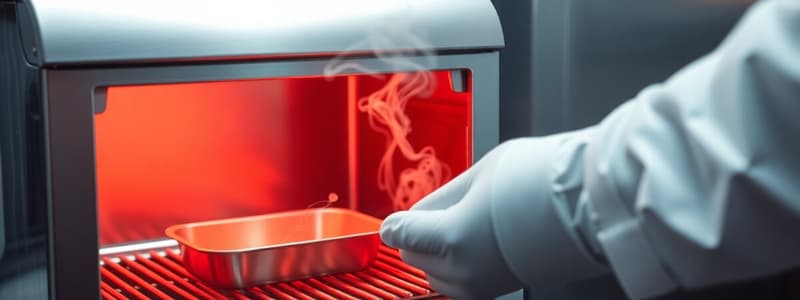Podcast
Questions and Answers
What is the primary purpose of applying heat in the control of pathogenic microorganisms?
What is the primary purpose of applying heat in the control of pathogenic microorganisms?
- To enhance the efficacy of other agents
- To promote microbial resistance
- To reduce microbial growth
- To achieve sterilization (correct)
Which method involves the use of dry heat at 160°C for sterilization?
Which method involves the use of dry heat at 160°C for sterilization?
- Hot air oven (correct)
- Chemical sterilization
- Incineration
- Boiling water
How does moist heat typically kill microorganisms?
How does moist heat typically kill microorganisms?
- By inhibiting enzyme activity
- By oxidizing the cell membrane
- By coagulating and denaturing proteins (correct)
- By hydrolyzing nucleic acids
Which of the following statements about boiling water sterilization is accurate?
Which of the following statements about boiling water sterilization is accurate?
What is a critical use of direct flame in the sterilization process?
What is a critical use of direct flame in the sterilization process?
What type of items is a hot air oven most suitable for sterilizing?
What type of items is a hot air oven most suitable for sterilizing?
What happens to the tip of a culture tube before sample collection?
What happens to the tip of a culture tube before sample collection?
Which method of sterilization effectively utilizes immersion to enhance heat penetration?
Which method of sterilization effectively utilizes immersion to enhance heat penetration?
Flashcards
Sterilization
Sterilization
The complete removal of all life forms, including bacteria, viruses, fungi, and spores, from an object or surface.
Direct Flame (Incineration)
Direct Flame (Incineration)
A method of sterilization using direct exposure to a flame, typically for inoculating tools like loops and needles.
Hot Air Oven
Hot Air Oven
A high-heat sterilization method using a dry heat oven to kill microbes and spores, often used for glassware and powders.
Boiling Water Sterilization
Boiling Water Sterilization
Signup and view all the flashcards
Heat Penetration
Heat Penetration
Signup and view all the flashcards
Exposure Time
Exposure Time
Signup and view all the flashcards
Coagulation and Denaturation of Proteins
Coagulation and Denaturation of Proteins
Signup and view all the flashcards
Physical Control of Pathogenic Microorganisms
Physical Control of Pathogenic Microorganisms
Signup and view all the flashcards
Study Notes
Physical Control of Pathogenic Microorganisms
- Heat is the primary physical agent for controlling pathogenic microorganisms.
- The goal of heating is sterilization, which eliminates all living organisms.
Methods of Sterilization Using Heat
-
Direct Flame (Incineration):
- Used to sterilize inoculation loops and needles.
- Used to sterilize the tips of culture tubes.
-
Hot Air Oven:
- Uses dry heat at 160°C for 2 hours.
- Effective for sterilizing dry powders, oils, and glassware.
- Kills bacterial spores and other microbial structures.
-
Boiling Water:
- Uses moist heat by immersing items in boiling water (100°C).
- Requires at least 2 hours for complete spore destruction.
- Kills microbes by denaturing and coagulating proteins.
Studying That Suits You
Use AI to generate personalized quizzes and flashcards to suit your learning preferences.



